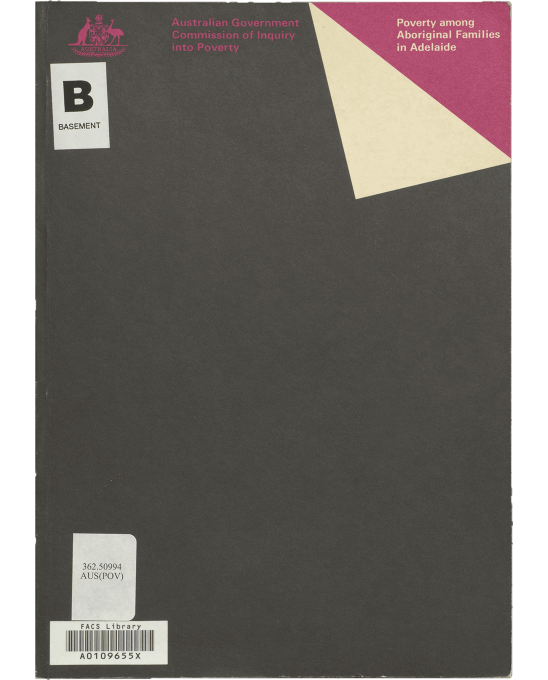
Report looks at impacts of payments on Aboriginal families
Researchers interviewed Aboriginal families in Adelaide about their housing, income, government payments and work as part of a wider study into poverty in Australia.
The present system of social security encourages wives in poor families to leave their husbands ... Although a deserted wives’ pension is barely adequate, it is secure and reliable.
| Attachment | Size |
|---|---|
| poverty-among-aboriginal-families-in-adelaide.pdf | 10.99 MB |
| Attachment | Size |
|---|---|
| poverty-among-aboriginal-families-in-adelaide-excerpts.docx | 129.65 KB |
In 1972, the government ran a Commission of Inquiry into Poverty in Australia. The commission looked into how much poverty there was in Australia, the factors behind it and how poverty could be reduced.
Researchers Joan Binnion and Dr Fay Gale wrote this report as part of the commission’s research. They interviewed Aboriginal people in Adelaide about their housing, income and work experiences. They wanted to find out whether government support was helping Aboriginal people in poverty or making their situations worse.
Interview methods
Binnion and Gale had to build trust with Aboriginal families to do interviews with them. People were worried about losing their payments if they answered certain questions. The researchers worked with Aboriginal field officers to introduce them to families. They asked questions in a conversational way and made sure to keep people’s identities confidential.
Community concerns about Unemployment Benefit
One factor the researchers looked at was whether people were getting an income from waged work or through government payments. They found there was a high proportion of Aboriginal people relying on pensions or Unemployment Benefit for their income. Across 70 households, they found that 69 out of 157 people interviewed were getting government payments.
The researchers found that many of the people getting Unemployment Benefit in Aboriginal households were considered able to work and they noted that many were young adults. This was also true in the broader community because of the economic downturn in the early 1970s.
However, interviews showed that some older Aboriginal women were negative about young people getting unemployment payments. They said they were concerned that ‘money comes too easy’.
Payment sharing in communities
The researchers found that Aboriginal families often shared government payments and that this was better for them economically. Extended families lived together in a single household, pooling and redistributing payments and other resources. People interviewed said ‘us Nungas always help each other’ and ‘sharing is a necessary part of our lives’.
As well as getting more income from payments, people getting a payment also got benefits such as reduced rent, cheaper fares and more medical support. This made pensions even more valuable to families.
Women’s access to payments
Women in Australia had begun to gain more access to government payments and better paid employment over the years leading up to this research. This meant they were generally becoming less financially reliant on a ‘male breadwinner’.
The researchers considered how this impacted Aboriginal families. They found as women were able to access government payments directly, women were not feeling tied to male partners for their ability to share income. In one interview, an Aboriginal woman said her friend told her she would get ‘a lot more money’ if she left her husband and applied for a payment.
The researchers seemed to stress the importance of marriage and a nuclear family structure with a male breadwinner, which reflected common values at the time.
Low wages for men
The authors found that Aboriginal men were often so poorly paid that wages were less than government payments. Also, if couples had several children, they would get more money to care for the children if the man was receiving Unemployment Benefit. The researchers concluded that families with one income ‘would have been better off if the fathers had left their jobs and taken unemployment benefits’.
The researchers raised some concerns about Aboriginal men’s status in society. They suggested that the combination of forced movement to urban areas, low employment opportunities, and the way the social security system worked was having a negative impact.
The report argued that an adequate minimum wage could help address some of these concerns.
Recommendation of direct payments
Through their report, the authors addressed some negative stereotypes held at the time about Aboriginal people. However, some of their views also seemed paternalistic.
Ultimately, they said Aboriginal households, including those living mainly on payments, were able to manage their money. The authors recommended that government money go directly to Aboriginal families, rather than through third parties.
The study was undertaken in 1973 by Dr Fay Gale and Joan Binnion, academics at the University of Adelaide. This report was published by the Australian Government Publishing Service in 1975.
The Department of Social Services Library has held this report since 1992.
The Commission of Inquiry into Poverty in Australia ran between 1972 and 1975 and was broad in scope. It included a nation-wide call for submissions, 2 national surveys and 34 studies.
The outcome included 5 major reports. Access the commission’s first major interim report from March 1974 and the first main report from April 1975 on the Trove website.
One of the commission’s main recommendations to address poverty included raising the amount of social security payments as part of a Minimum Income Guarantee. Although the government didn't implement these recommendations, researchers describe the reports as influential (Regan 2014:20–26). The ‘Henderson poverty line’ came out of this research and is still often used as a standard for measuring poverty today.
Permissions
Permission to reproduce excerpts from the report was granted by Joan Binnion.
Citation
Gale F and Binnion J (1975) Poverty among Aboriginal families in Adelaide: research report, Australian Government Publishing Service, Canberra.
